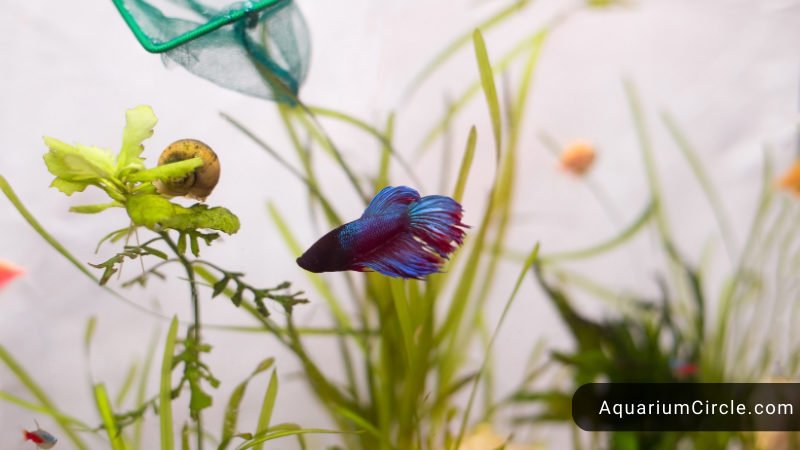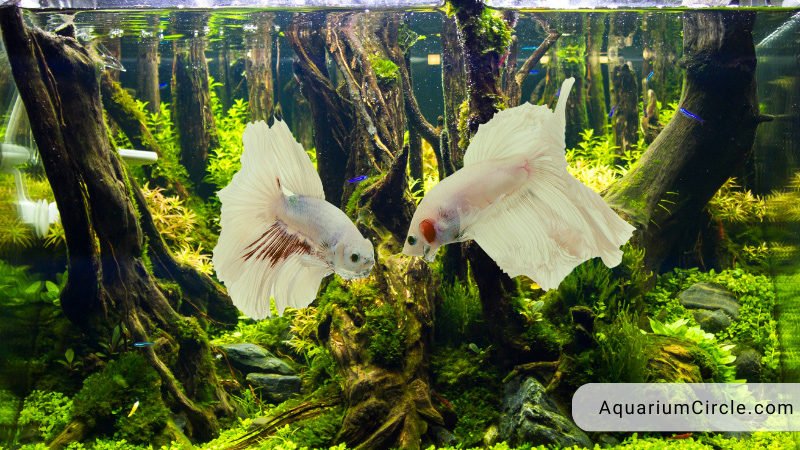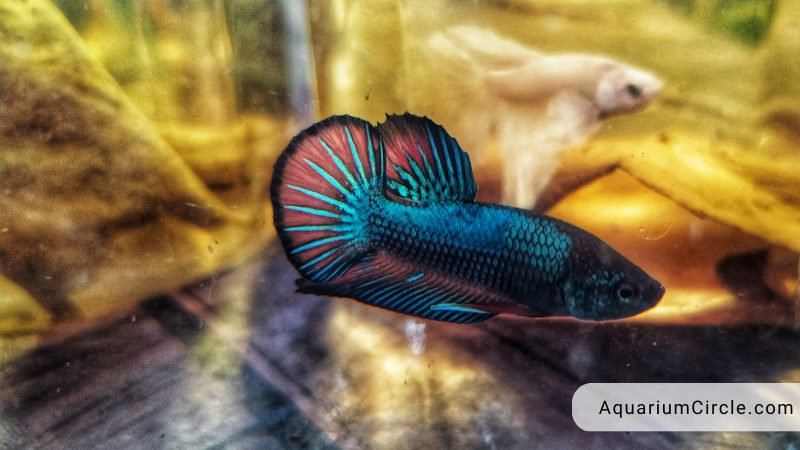Betta fish, also known as Siamese fighting fish, are a popular and colorful addition to many aquariums. While male betta fish are known for their aggression and territorial behavior, the question remains: can female betta fish live together peacefully? The answer is yes, but with some important considerations.
In this blog post, we will explore the topic of female betta fish cohabitation, including the factors that influence their ability to live together, the risks and benefits of keeping female bettas in groups, and tips for setting up a tank for multiple female bettas. So, if you’re considering adding female betta fish to your aquarium, keep reading to learn more about whether or not they can live together.
See also:
- Can Male And Female Betta Fish Live Together? How Can You Put A Male And Female Betta Fish Together Peacefully?
- Top 3 Most Crucial Things To Know Before Getting A Multiple Betta Fish Tank
- Betta Fish Natural Habitat: Where Do Betta Fish Come From And How Do They Live In Wild Environment?
Background Information On Female Bettas

Before we dive into the question of whether female betta fish can live together, it’s important to understand some background information about these colorful fish.
Physical characteristics
Female betta fish have several distinctive physical features that set them apart from their male counterparts. One of the most obvious differences is their shorter fins, which are more rounded and lack the dramatic flowing shape of male betta fins. Female bettas also tend to be smaller in size, with a slimmer body shape and a smaller head. They have a similar body shape to male bettas, with a pointed head and elongated body, but with a more subtle curve. In terms of coloration, female bettas typically have less vivid and intense hues than male fish, but still come in a range of colors and patterns, including solid colors, bi-colors, and marbled patterns.
Behavior patterns
Beside physical characteristics, Female betta fish also have their own unique behavioral patterns that differentiate them from their male counterparts. While male bettas are known for their aggression and territorial behavior, female bettas tend to be more peaceful and social. However, they can still be territorial and assertive towards one another, especially in cramped or poorly decorated environments.
In the wild, female bettas live in large groups and have a well-established hierarchy, with dominant females taking charge of the group. In captivity, female bettas can also live together in groups, but it’s important to provide them with enough space and hiding spots to establish their own hierarchy and minimize aggressive behavior. Female bettas also tend to be less active and energetic than male bettas, spending more time resting and exploring their surroundings.
Differences Between Female And Male Bettas
After showing physical characteristics as well as behavior patterns, we can conclude that male and female betta fish have distinct physical and behavioral differences. Male bettas are known for their long, flowing fins, bright and vivid colors, and aggressive territorial behavior. In the wild, they live alone and defend their territory against other males. Female bettas, on the other hand, have shorter, rounded fins and less intense coloration. They are generally smaller in size than males and can be more social, living together in groups in the wild.
However, in captivity, female bettas can still be territorial and assertive towards each other if they don’t have enough space and hiding spots to establish a hierarchy. Female bettas can lay eggs and spawn with a male betta, while male bettas are responsible for fertilizing the eggs. Understanding these differences is crucial for providing suitable care for each type of fish and ensuring their overall health and well-being.
See also: Betta Bubble Nest: What Is It & Why Are Betta Fish Making It?
Can Female Betta Fish Live Together?
Yes, female betta fish can live together, but it requires a proper tank setup and monitoring to ensure their well-being and prevent aggressive behavior.
It is a well-known fact that male betta fish cannot live together as they tend to be aggressive and territorial towards each other. In contrast, female betta fish can be kept together in a properly set up aquarium with careful introduction techniques. These types of aquariums are called “female betta fish sorority tanks” and can house multiple female bettas. While male bettas are hot-tempered, females can coexist peacefully with the right conditions.
Keeping Two Female Betta Fish Together: What Factors Should We Consider?

If you’re considering keeping female betta fish together in the same aquarium, it’s important to consider a few factors to ensure their well-being and happiness. Keep reading to figure out what are they.
Tank size
Female bettas need adequate space to swim around and establish territories without feeling cramped or stressed. The recommended tank size for a female betta sorority is at least 20 gallons. A larger fish tank provides more swimming room, and females are less likely to feel cramped, which can reduce aggression and territorial behavior.
Aquarium setup
Female bettas need plenty of hiding spots and plants to create boundaries and break up the line of sight. This can reduce stress and aggression by allowing the females to establish their territories and retreat when feeling threatened.
Water parameters
Keeping the water parameters stable and within the recommended range is crucial for the health and well-being of the female bettas. Regular water changes and testing are essential to maintain the right pH, temperature, and chemical balance in the water.
Fish compatibility
While female bettas can live together, it’s important to avoid keeping them with other aggressive fish or fish that are too small to defend themselves. It’s best to stick with other peaceful community fish that won’t disrupt the social dynamics of the female betta sorority.
Introducing fish
Introducing female bettas to each other requires a gradual process that allows them to get used to each other’s presence without aggression. The introduction process typically involves placing the new female in a separate container within the tank and gradually increasing the time she spends in the tank with the other females.
See also: Do Betta Fish Like Light? Your Answer Is Right In This Post!
Risks Of Keeping Female Bettas Together In A Tank

While it’s possible to keep female bettas together in a sorority tank, there are certain risks and challenges involved.
Keeping female bettas together in a tank can be risky because these fish are known to be aggressive towards one another. Although female bettas are less aggressive than males, they still have a tendency to establish a pecking order or hierarchy within a group.
When several female bettas are kept in the same tank, they may become territorial and may display aggressive behavior towards each other. This can result in fighting and injuries, which can be fatal in extreme cases.
Additionally, female bettas can become stressed if they do not have enough space to establish their own territory. This can lead to health problems and a weakened immune system, making them more susceptible to diseases.
See also: Swim Bladder Disease Betta – Betta Care To Be Aware Of
If you want to keep multiple female bettas in a tank, it is important to provide plenty of space, plants, and hiding places to reduce aggression and establish territories. It is also important to monitor the fish closely for signs of aggression or stress and to separate any fish that show signs of aggression.
Setting Up A Tank For Female Bettas

If you’re considering keeping female bettas together in a sorority tank, it’s essential to set up the tank correctly to ensure the well-being of your fish. Here are some tips for setting up a tank for female bettas:
- Tank Size: As mentioned earlier, a larger betta tank size is ideal for female betta sorority tanks. A minimum of 20 gallons is recommended to provide enough space for each fish to establish their territory and swim freely.
- Decoration: Female bettas need plenty of hiding spots and decorations in the tank to create boundaries and break up the line of sight. This can reduce stress and aggression by allowing the females to establish their territories and retreat when feeling threatened. Live plants, caves, and driftwood are great options for creating hiding spots.
- Water Parameters: Female bettas require stable water parameters to thrive. The recommended water temperature is between 76 and 82 degrees Fahrenheit, and the pH level should be between 6.5 and 7.5. Regular water changes and testing are necessary to maintain good water quality.
- Filtration: A good filtration system is essential for keeping the water clean and free of harmful bacteria and toxins. A filter with a flow rate of at least 10 times the tank volume per hour is recommended.
- Fish Compatibility: When selecting fish to add to the sorority tank, it’s important to choose peaceful, non-aggressive fish that won’t disrupt the social dynamics of the female betta sorority.
- Introduction Process: Introducing new fish to the sorority tank requires a gradual process that allows them to get used to each other’s presence without aggression. It’s important to monitor the fish during the introduction process to ensure they’re getting along.
By following these tips, you can set up a safe and comfortable home for your female betta sorority.
Video About Female Betta Fish Living Together
FAQs
How many female betta fish we can keep together in a tank?
A group of 4-6 female betta fish can live together in a tank, provided that the tank is large enough to accommodate them and there are enough hiding spots to establish a hierarchy.
How do you introduce female betta fish to each other?
Female betta fish should be introduced to each other gradually and in neutral territory. Watch their behavior closely and remove any fish that shows aggression towards the others.
Do female betta fish fight each other?
Yes, female betta fish can fight each other, especially if there is not enough space or hiding spots in the tank to establish a hierarchy. However, with proper tank setup and monitoring, female bettas can live together peacefully.
References

Annette M. Chaney is an experienced marine biologist with over 20 years of experience as an aquarist and fishkeeper. She started her first aquarium at a young age, filling it with frogs and goldfish obtained from the ten-cent pet store.
Annette grew up caring for and breeding African Cichlids, which led to a hobby in high school that doubled as a profitable means. Attending Reed College gave her time to solidify herself as an accomplished aquarium caretaker with an eye for sales. After that, from 2009 – 2013, she studied at Roger Williams University – one of the most prestigious universities for Aquaculture and Aquarium in USA. She is the founder of AquariumCircle since 2010.
